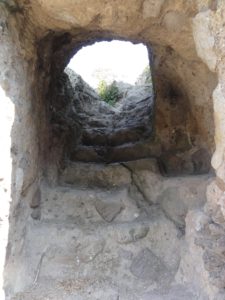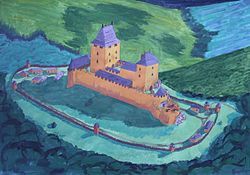Drégely

Drégely Castle is located in northern Hungary, near the Slovakian border. Its ruins are situated on a hilltop, guarding the basin of the Ipoly River where it meets the Börzsöny Hill. Every Hungarian has heard of the brave siege of Drégely and the heroic death of its captain, Szondi György, so it is present in the historical consciousness of this nation. This small castle deserved to become as famous as Kőszeg or Szigetvár in the Turkish wars.

The fortress was built by the Bozóky line of the Hont-Pázmány dynasty between 1275 and 1285, the golden age of Hungarian castle building. The name of Drégely first appeared in 1285. The small castle was taken over by Csák Máté, the notorious oligarch, the lord of northwestern Hungary at the beginning of the XIV century. After his death (1321), Drégely became a royal estate in the middle of the XIV century, under the rule of the Anjou dynasty.
In 1388 it was taken by a Moravian marquis, but King Sigismund took it back and gave it to the Tari family in 1390. After a generation, it became a royal estate again for fifteen years, and then Albert Habsburg gave it to the archbishopric of Esztergom. The small castle was kept as a hunting palace of the bishops of Esztergom.

The troubles of the kingdom tore the country in two after the Battle of Mohács in 1526, and the age of the Dual Kingship began. Despite the warning of Emperor Charles V, the Habsburg King Ferdinand was in no hurry to make peace with King Szapolyai, who was forced to ally with Suleiman the Great.

Photo: Kocsis Kadosa
The Sultan secured his rule as the king of Hungary so Szapolyai could control the Eastern part of the kingdom, including Transylvania. The Sultan did not demand any taxes or services from him and it is a fact that Szapolyi never gave soldiers to Suleiman’s wars. Although Szapolyai is a dividing person, he was far from being a mere vassal of the Ottomans.

The noblemen of Hungary have switched sides often enough between Szapolyai and Ferdinand and the high priests were no exceptions to this. For instance, Várday Pál, Archbishop of Esztergom, used to be one of those who initiated the betrothal of Szapolyai at Tokaj, after 1526. When Suleiman was leading his army against Vienna in the fall of 1529, Várday fled to Drégely Castle.

Photo: Lánczi Imre
Yet, we can find this high priest on Ferdinand’s side in the camp of General Roggendorf in 1531. The consequences of his betrayal of Szapolyai hit the inhabitants of Drégely, though. Three years later, the Serbian, Turkish, and Hungarian soldiers of Szapolyai set the small agricultural town on fire and herded their cattle away. When King Ferdinand tried to take Buda from Szapolyai in 1536, Ottoman troops arrived to break the siege and these very soldiers took advantage of the situation and pillaged great areas of the Upper Lands, including Drégely. After Buda fell into the hands of the Muslims in 1541, King Ferdinand had to create a new chain of defense in the north, too.

This frontier line was designed by Archbishop Várday and by Chief Commander of the Habsburgs, Nicholas Graf zu Salm in the second half of the 1540s. They had to select those forts that were supposed to be reinforced and pull down the rest which was undefendable. North of the Danube River, the castles worth renovating were Drégely, Ság, Pásztó, Szécsény, Buják and Léva.

You can read more about the 1,000-mile-long Hungarian-Croatian-Transylvanian Borderland that had separated the western part of Europe from the Ottoman Empire from the 1400s to 1699 here:
https://www.hungarianottomanwars.com/essays/the-borderland/
Nógrád castle was taken by Pasha Mehmed in 1544 and this important castle in the neighborhood of Drégely became their basis for raiding the Upper Lands of Royal Hungary. During the winter of 1543-44, the Turks burned the village called Oroszi next to Drégely. It was the year when Drégely became a frontier castle, guarding the gate to the mining towns of Upper Hungary, especially towards Selmecbánya. As King Szapolyai died in 1541, his widow, Queen Isabella was ruling in East Hungary, led by the powerful and ingenious Paulin monk and statesman, Brother György. Forced by him, the Queen made a treaty with Ferdinand and ceded him Transylvania.

At the summit of Brother György`s political career, the Diet of Kolozsvár (Cluj, Klausenburg) swore fealty to Ferdinand and asked for his protection against the Turks. Brother György, the “White Monk” was a good soldier as well: he turned against Suleiman`s troops and scattered them at Temesvár and Lippa.

Soon after this, the high priest was shamefully assassinated by King Ferdinand. The weak truce between King Ferdinand and Sultan Suleiman was broken in 1551. Yet, Suleiman regarded Queen Isabella`s son, János Zsigmond as the king of East Hungary and sent his troops to take revenge on Ferdinand. He sent three armies against the Habsburg king. He aimed to divide the western and eastern parts of Hungary to separate Transylvania from Ferdinand and to open a border with Poland.

Pasha Achmed, the Grand Vizier led the campaign and his forces soon took Temesvár and Szolnok castles. The second army which was supplemented with Tatar troops and the units of two Wallachian voivodes kept the Christian army of Transylvania at bay. It was the third, the smallest army with 10-12,000 men which began a campaign in the East-Trans Danubian Region. After taking Veszprém Castle, they turned towards the mining cities of the Upper Lands. Their leader was Hádim Ali, the Pasha of Buda also called the Gelded. His first roadblock was Drégely Castle with Captain Szondi György in it.
The life of Szondi (Szondy) György
It is thought that Szondi György was not coming from a noble family, he most likely derived from a simple burgher family in a small market town or even from the peasant class. He must have gained his nobility for his services. He was born in the settlement called Szond, in Bács County which can be found in the southern part of the Hungarian Kingdom. His family name was Szuhó but he called himself Szondi. (It means in the Hungarian language that he had come from Szond.) His family had to flee from the Ottoman expansion toward the north like so many people. We know that he had a brother called Jakab. Szondi György was born after 1500, perhaps in 1504.

The noble Révai family paid for his education, they also had come from the southern lands of Hungary, from the szerémség (Sirmium) Region. It is supposed that the Szuhó family must have served the Révai family for a long time. They fled together to the area of Drégely castle after the years of the Battle of Mohács (1526). Szondi György is supposed to have spent his childhood and young years in the domains of Révai Ferenc in Szklabinya. He learned to read and write and began his military career. Later, he became renowned as a Borderland warrior and was in the service of the Archbishop of Esztergom because we know that it was Archbishop Várday Pál who appointed him as the captain of Drégely castle.



The siege of Drégely castle






The defenders had caused great losses to the enemy and their example encouraged the Hungarian warriors all along the Borderland. The Turks went on and took the frontier castles of Gyarmat, and Szécsény, and finally, Ali defeated General Teuffel in the Battle of Palást, two months later. The cowardly leader was carried to Istanbul and was impaled in front of the Sultan.
For the time being, only the small castle of Bussa followed the example of Drégely, hindering the Turks in their victorious campaign but the defenders of Eger castle must have taken courage because Captain Dobó István repelled the over-confident Ottomans. However, two years later Fülek and Salgó castles were occupied by the Turks, and the first system of castles along the border was established by the Ottomans. Read the story of the Battle of Palást here:
https://www.hungarianottomanwars.com/dramatized-historical-writings/the-battle-of-palast-1552/

In 1575, Új-Drégely (New-Drégely), or differently Palánk was built by the fortification of the church in Drégely. The Ottoman Turks did not renovate the old castle on the hilltop, instead, they built a strong palisade that was capable of holding 2,000 riders. This kind of palisade extension was called “huszárvár” or hussar castle at that time. The new castle became the headquarters of the raids aiming at the mining towns. This was the center where taxes imposed on the population of the region were collected. The population of the medieval borough of Drégely did probably not reach a thousand.

The Hungarian population grew with some Germans at the beginning of the XVI century. They, however, left the settlement during the Turkish rule and escaped to better-protected areas. South Slavic people came to the settlement during the years of the occupation. This palisade castle was taken back by General Pálffy in 1593, at the beginning of the so-called Long War that lasted for 15 years. Hungarian military command considered it again as a border fortress for two decades.

General Pálffy left Nagy Ferenc in charge of the fort, as a castellan. The place used to remain the target of constant Turkish attacks which were beaten back repeatedly. Due to the lack of payment, the defenders’ number of Drégely decreased to a mere ten soldiers in December 1595. They were not enough to protect the surrounding villages so the settlements fell into the Turks’ hands and paid taxes to them. Fortunately, the garrison’s number was increased the next year and they withheld the renewed Turkish attacks.

The Diet of 1604 ordered the reinforcement and the full renovation of the castle but it remained just a promise. The castle, repaired and strengthened after the Tatar raid of 1599, was subdued by the commanders reporting to the princes of Transylvania at the time of the Thirty Year War.

During the military campaign of Köprülü Ahmed, the Grand Vizier in 1663, Érsekújvár (Nove Zámky) fell, and hearing the news, the guards of Drégelypalánk set the castle on fire and escaped. The palisade was beyond repair but it was somewhat repaired in 1615, though. During the Habsburg-Transylvanian wars, Prince Bethlen Gábor was camping his army next to Drégely castle in 1626, waiting for the chance to fight General Wallenstein.

After the liberation from Turkish rule, two legally separated villages could start their new lives, Drégely and Palánk. Drégely, which was mentioned as a borough in sources from the XVI-XVII centuries, degraded to the status of a serf village owned by the church.

Palánk (it stands for „palisade” in the Hungarian language), which was born in the middle of the XVI century, preserved some of its freedom as a border castle. The leading authority of the settlement was a lieutenant and not a judge. Its population, mostly craftsmen, were exempted from socage, and tithe. They worked as an escort to the lords, they delivered the post and collected and safeguarded the tithe.

In the first third of the XVIII century, German settlers arrived to populate Drégely and Palánk, which were organized into a village and now called Drégelypalánk.

Source: partly by Szibler Gábor
Dear Readers, I can only make this content available through small donations or by selling my books or T-shirts:
Please, feel free to support me with a coffee here:
You can check out my books "33 Castles, Battles, Legends" and "The Ring of Kékkő Castle" on Amazon or Draft2Digital, they are available in hardcover, paperback, or ebook: https://www.amazon.com/dp/198020490X or at https://books2read.com/b/boYd81
 My work can also be followed and supported on Patreon: Become a Patron!http://Become a Patron!
My work can also be followed and supported on Patreon: Become a Patron!http://Become a Patron!


https://hungarianottomanwars.myspreadshop.com/all




































